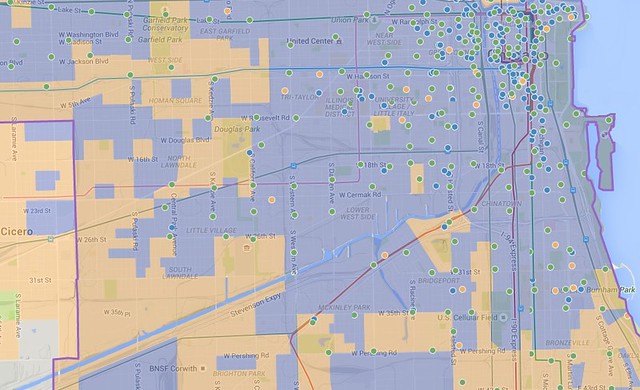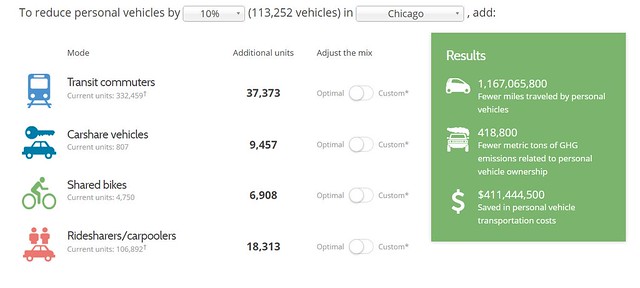
The Chicago-based Shared-Use Mobility Center hopes their new interactive toolkit, released last week, will help cities expand the use of car-sharing, bike-sharing, and other forms of shared mobility, especially in low-income communities with limited transportation options. The toolkit includes a Shared Mobility Benefits Calculator, a Shared Mobility Policy Database, and an Interactive shared Mobility Mapping and Opportunity Analysis Tool.
SUMC executive director Sharon Feigon says the toolkit was developed in partnership with 27 North American cities through the Urban Sustainability Director’s Network. “They wanted to better understand and manage shared-mobility as new technologies emerge,” she said. “We’re hopeful that our toolkit will shed some light on how these technologies are working and shine some light on best practices.” To supplement the toolkit, they've also produced a report with an overview of each tool, plus policy recommendations, trends by city, size, and type, and shared mobility growth scenarios for each of the cities.
“Our interest is to really encourage the use of transit along with shared mobility to decrease the use of private cars,” Feigon added. “Our vision sees public transportation as the backbone and shared mobility as something that can enhance the transit system.” For example, services like bike-sharing and one-way car-sharing can facilitate “last mile” trips to and from rapid transit in locations where its difficult to access a station by walking or a fixed-route bus.
One-way car-sharing services like Car2Go, which allow customers to pick up a small car, drive it a short distance and leave it at any number of designated parking spots around town, have been popular in cities like New York, Washington, D.C., and Seattle. But Feigon said the mode hasn’t come to Chicago yet because of the complications caused by our city’s much-reviled parking contract. Mayor Emanuel’s office is currently looking into whether it could be implemented here, she said.
The benefits calculator allows cities to see the potential benefits of adding shared mobility nodes such as car-share and bike-share vehicles. For example, the calculator projects that – based on June 1, 2016 figures -- Chicago could eliminate ten percent of private vehicle trips by adding 37,373 transit commuters, 8457 car-share vehicles, 6,908 bike-share cycles, and 18,313 ride-sharers or car-poolers. The result would be 11,167,065,800 fewer vehicle miles traveled, 418,800 fewer metric tons of emissions from personal vehicles, and $411,444,500 saved in personal vehicle transportation costs.
The mapping and opportunity analysis tool shows shared use mobility vehicles in 54 North American cities. It also includes other information, such as Census data and info on the quality of transit service to help cities understand where more transit and shared-mobility resources are needed, and where there’s potential for car-sharing and bike-sharing to succeed. Zooming in on Chicago shows you all the locations for Divvy, Zipcar, Enterprise CarShare, and Getaround (peer-to-peer car-sharing), as well as, ‘L’, Metra, and bus lines.
Feigon says the map shows that there are areas around the Red Line on the South Side and the Orange Line on the Southwest Side that don’t yet have car-sharing or bike-sharing, but have the transit access, density, and walkability needed to make these modes successful. “A lot of these technologies start in not-low-income neighborhoods,” she said, noting that while Chicago’s Divvy system was initially concentrated downtown and in Near North neighborhoods, the current wave of installations is focused on the South and West sides.
While Divvy is currently expanding further south and southwest, Feigon said there’s potential for car-sharing to be successful in these areas. One-way car-sharing and ride-splitting services such as Uber Pool and Lyft Line would be especially useful for last mile trips to and from stations, she said.
Feigon added that the interactive map will help shared mobility companies find areas that are ripe for expansion of their systems. “Transit deserts are similar to food deserts,” she said. “Once companies open up grocery stores in underserved neighborhoods, they find that these are some of their highest-grossing stores because there was an unmet demand." Likewise, low-to-moderate-income neighborhoods are places where residents could greatly benefit from increased transportation options and reduced travel costs, so shared mobility may get good use when it’s introduced to these areas.
The mobility policy database contains more than 700 of shared mobility policies, studies, and strategic plans in North America “It was all the legislation we could finds at the city and state levels, as well as public utility commissions,” Feigon said. The database also provides best practices, case studies, and analysis to help local governments make informed decisions about the best ways to regulate ride-sharing, car-sharing, and bike-sharing.
Feigon says that, in spite of problems with the local transportation system, Chicago is doing a lot things right when it comes to shared mobility. “We’d love to work with agencies like [the Chicago Department of Transportation], the CTA, and Pace to use the information from the toolkit to continue to make positive changes,” she said.
“As [U.S. transportation secretary Anthony] Foxx said, transportation is a civil right – it provides access to jobs and economic opportunities,” Feigon said. “Private automobiles are really expensive and have many detrimental effects. So creating more non-single-occupant options is really important for the health of cities and the people in them.”





